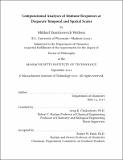| dc.contributor.advisor | Arup K. Chakraborty. | en_US |
| dc.contributor.author | Wolfson, Mikhail Yanislavovich | en_US |
| dc.contributor.other | Massachusetts Institute of Technology. Department of Chemistry. | en_US |
| dc.date.accessioned | 2013-04-12T15:14:03Z | |
| dc.date.available | 2013-04-12T15:14:03Z | |
| dc.date.copyright | 2012 | en_US |
| dc.date.issued | 2012 | en_US |
| dc.identifier.uri | http://hdl.handle.net/1721.1/78361 | |
| dc.description | Thesis (Ph. D.)--Massachusetts Institute of Technology, Dept. of Chemistry, 2012. | en_US |
| dc.description | This electronic version was submitted by the student author. The certified thesis is available in the Institute Archives and Special Collections. | en_US |
| dc.description | Cataloged from student-submitted PDF version of thesis. | en_US |
| dc.description | Includes bibliographical references (p. 139-147). | en_US |
| dc.description.abstract | In order to perform reliably and protect against unpredictable attackers, immune systems are organized via complex, hierarchical cooperativity. This organization is necessary for their function and a tremendous challenge to their understanding that has motivated contributions from many outside fields. Our approach to studying the immune system computationally has been pragmatic: we have applied any analysis method necessary to understand questions motivated by experimental biology, rather than use biology specifically to discover new physics or methods. Our approach has led us to study problems that span a wide range of time and length scales and require a diverse set of solutions. This thesis describes three projects that span the extremes of this range, from nanometers over nanoseconds to organism-wide responses over hours. The first project was motivated by a puzzle: experimentalists had reached opposing conclusions on the role of a peptide fragment in the main protein interaction responsible for immune recognition. We used molecular dynamics simulations of the proteins to resolve the contradiction by creating a unifying model. The second and third projects jump from the molecular to the system-wide. In the second project, we sought to understand which phenotypes of cancer-fighting immune cells were the most important. To do this, we developed novel data visualizations and applied multivariate dimensionality reduction and regression to understand high-dimensional immunotyping data collected on the phenotypes. The final project addressed an important question in immunology: how accurately do blood assay results reflect the immune response in the tissues, where it matters most? We explored this relationship using a supervised learning model of a highly multidimensional dataset that combined blood and tissue measurements. We found that the two environments could be drastically different and that the relationship mapping blood to tissue was complex. Combined, these three projects highlight the variety of scientific questions and richness of insight that occur at the intersection of immunology and computation. | en_US |
| dc.description.statementofresponsibility | by Mikhail Yanislavovich Wolfson. | en_US |
| dc.format.extent | 147 p. | en_US |
| dc.language.iso | eng | en_US |
| dc.publisher | Massachusetts Institute of Technology | en_US |
| dc.rights | M.I.T. theses are protected by
copyright. They may be viewed from this source for any purpose, but
reproduction or distribution in any format is prohibited without written
permission. See provided URL for inquiries about permission. | en_US |
| dc.rights.uri | http://dspace.mit.edu/handle/1721.1/7582 | en_US |
| dc.subject | Chemistry. | en_US |
| dc.title | Computational analyses of immune responses at disparate temporal and spatial scales | en_US |
| dc.type | Thesis | en_US |
| dc.description.degree | Ph.D. | en_US |
| dc.contributor.department | Massachusetts Institute of Technology. Department of Chemistry | |
| dc.identifier.oclc | 831408504 | en_US |
